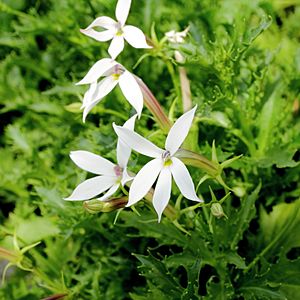Isotoma petraea facts for kids
Quick facts for kids Rock isotome |
|
|---|---|
 |
|
| Scientific classification | |
| Genus: |
Isotoma
|
| Species: |
petraea
|
Isotoma petraea, also known as the rock isotome, is a small plant that grows from year to year. It belongs to the Campanulaceae family. You can find it in the dry, desert-like areas of Australia. This plant has pretty purplish-blue flowers that grow one by one on thin, smooth branches. It usually blooms from February to November.
Contents
What Does the Rock Isotome Look Like?
The rock isotome is a plant that stands upright and can spread out. It can be a perennial (meaning it lives for more than two years) or an annual (meaning it lives for one year). Its branches are smooth and typically grow to be about 0.2 to 0.6 meters (or about 0.6 to 2 feet) tall.
Leaves and Flowers
The leaves of the rock isotome are smooth and shaped like a narrow egg or oval. They are about 3 to 7.5 centimeters long and 1 to 3.5 centimeters wide. The lower leaves have a small stem called a petiole, while the upper leaves are directly attached to the branch. The edges of the leaves have sharp, uneven teeth and end in a point.
The beautiful blue-purplish flowers grow one at a time on a thin stalk called a peduncle, which can be 8 to 25 centimeters long. The green parts that protect the flower bud, called calyces, are narrow and pointed, about 5 to 12 millimeters long. The main part of the flower, the corolla, is mostly white, but it might have a touch of purplish-blue. It has a light green tube about 14 to 20 millimeters long with clear veins. The smooth petals are shaped like a spear, about 9 to 12 millimeters long, and they taper to a sharp point.
Fruit
After the flowers, the plant produces rounded fruits that have slight ridges. These fruits are about 12 to 22 millimeters long. The rock isotome mostly flowers during the summer months.
How Did the Rock Isotome Get Its Name?
This plant was first officially described in 1853 by a scientist named Ferdinand von Mueller. He published his description in a journal called Linnaea: ein Journal für die Botanik in ihrem ganzen Umfange, oder Beiträge zur Pflanzenkunde.
The second part of its scientific name, petraea, comes from the Latin word petraeus. This word means "growing among rocks," which perfectly describes where this plant likes to live!
Where Does the Rock Isotome Grow?
The rock isotome can be found in several parts of Australia. It often grows on rocky slopes, among rocky outcrops, and in cracks in rocks.
Locations in Australia
- In Western Australia, you can find it in the Mid West, Wheatbelt, and Goldfields-Esperance regions. Here, it grows in shallow sandy soils that are on top of granite rock.
- In New South Wales, it grows west of Wilcannia. It prefers slopes and rocky areas, usually in shallow soils that are also based on granite.
- In South Australia, the rock isotome is a common plant that grows in many rocky locations across the state.

